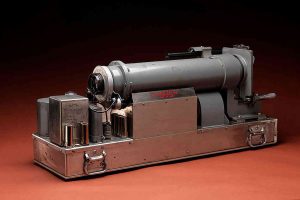![]() In 1947, together with two former students Edgerton founded a research company, EG&G, to fulfill contracts from the Atomic Energy Commission for timing and triggering systems for atomic bomb tests. Although photographing these tests had initially been the job of the Army Air Corps, results were not satisfactory. Having developed strobe flash techniques for photographing split- second events, such as a bullet bursting a balloon, Edgerton and his associate Charles Wyckoff realized new technology was needed to photograph the large-scale instantaneous flash of light generated by an atomic bomb.
In 1947, together with two former students Edgerton founded a research company, EG&G, to fulfill contracts from the Atomic Energy Commission for timing and triggering systems for atomic bomb tests. Although photographing these tests had initially been the job of the Army Air Corps, results were not satisfactory. Having developed strobe flash techniques for photographing split- second events, such as a bullet bursting a balloon, Edgerton and his associate Charles Wyckoff realized new technology was needed to photograph the large-scale instantaneous flash of light generated by an atomic bomb.

Edgerton and Wyckoff designed a camera capable of making exposures of 1/1,000,000 of a second. The “Rapatronic” (Rapid Action Electronic) camera used the principle of the Faraday Effect. In the nineteenth century, British scientist Michael Faraday discovered that it was possible to change the plane of a pair of polarizing filters by applying a magnetic field. When doing so, at one point the filters become opaque and no light is transmitted. Thus light can be blocked at extremely high speed. In place of moving parts of a camera’s shutter, the exposure could be controlled by turning a magnetic field on and off.
Mounted on a 75-foot tower seven miles from the blast, the cameras were attached to ten-foot long telescopes. Since each camera could hold only one exposure on a sheet of film, four to ten cameras were set up to make a series of exposures.